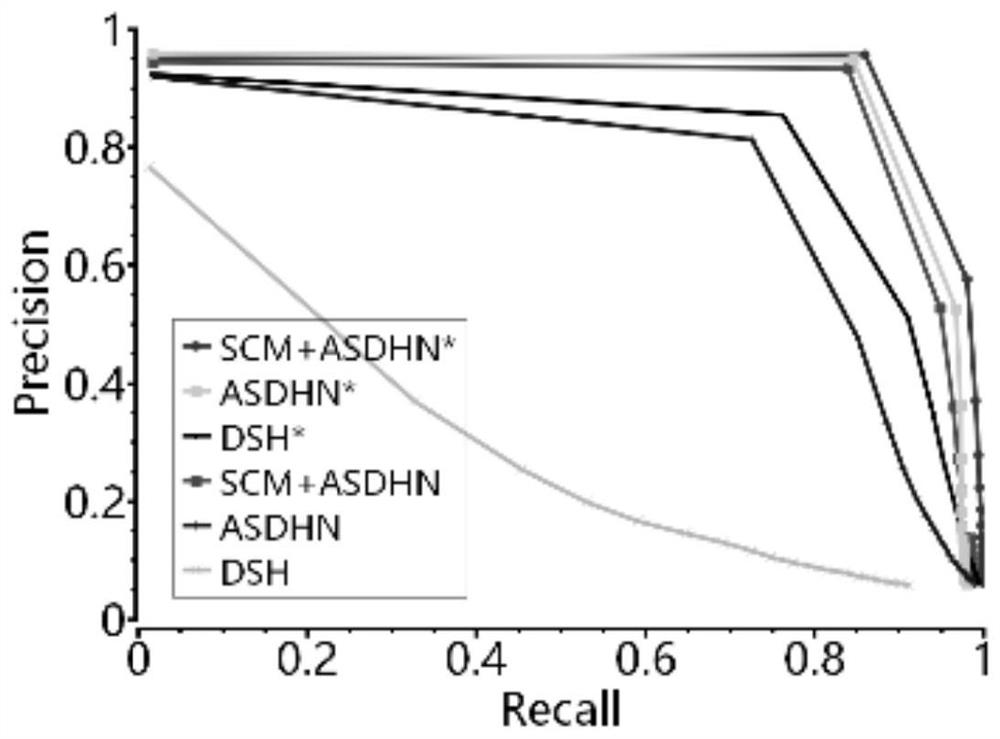Unbalanced trademark retrieval method based on deep hash of aggregation similarity
A similarity and trademark technology, applied in the computer field, can solve problems such as imbalance, data imbalance, and low accuracy of retrieval results, and achieve the effect of solving retrieval problems, improving representation ability, and high average accuracy
- Summary
- Abstract
- Description
- Claims
- Application Information
AI Technical Summary
Problems solved by technology
Method used
Image
Examples
Embodiment 1
[0060] An unbalanced trademark retrieval method based on deep hashing of aggregation similarity, specifically comprising the following steps:
[0061] S1. Construct the network architecture of the deep hash neural network based on aggregated similarity, and initialize the neural network parameters;
[0062] S2. Generate a trademark hash cluster center C={c through Hadamard matrix and good properties of Bern random sampling 1 ,c 2 ,...,c m},in, The trademark hash cluster center m is equal to the total number of trademark classes, and q is the number of digits of the hash code;
[0063] S3. Based on the trademark hash cluster center C preset in S2, construct a trademark semantic hash cluster center C'={c 1 ',c 2 ',...,c N ′}, N is the total number of samples in the trademark training set;
[0064] S4. For the training sample x of the trademark data set training set i , obtain the training set hash encoding set through the sparse hash encoding module;
[0065] S5. Calcu...
Embodiment 2
[0067] Based on Embodiment 1, this embodiment further explains the technical solution of an unbalanced trademark retrieval method based on deep hashing of aggregation similarity in the present invention.
[0068] An unbalanced trademark retrieval method based on deep hashing of aggregation similarity, specifically comprising the following steps:
[0069] S1. Construct the network architecture of the deep hash neural network based on aggregated similarity, and initialize the neural network parameters;
[0070] Such as figure 1 As shown, ASDHN, a deep hash network based on aggregated similarity, consists of a feature extractor based on convolutional neural network, a hash encoder based on aggregated similarity, and a classifier based on Hamming distance matching. The feature extractor selects the convolutional neural network architecture AlexNet as the backbone, such as figure 2 shown. The convolutional neural network architecture AlexNet consists of 7 weight layers, includi...
Embodiment 3
[0117] Based on the aggregation similarity-based deep hash network of embodiment 1 and embodiment 2 in the trademark retrieval method, this embodiment is respectively in the DrinkLogos-50 data set (can be found at github / xxx.com) and the public data set FlickerLogos-32 Experiments were carried out on the platform, and the current hashing methods with better effects in trademark retrieval applications were compared horizontally.
[0118] In the experiment, the hardware platform used is Ubuntu18.4 LTS system, 64GB memory, (NIVIDIA) GeForceRTX TM 2080 Ti graphics card*4; software environment is Python 3.7, Torchvision 0.5.0, Pytorch 1.4.
[0119] In the comparison process, the method of the present invention and the most advanced method of trademark hash retrieval are adopted respectively, and the backbone networks adopted are respectively AlexNet and ResNet. The network has been pretrained on ImageNet. Models employing the AlexNet backbone are marked with an asterisk.
[0120...
PUM
 Login to View More
Login to View More Abstract
Description
Claims
Application Information
 Login to View More
Login to View More - Generate Ideas
- Intellectual Property
- Life Sciences
- Materials
- Tech Scout
- Unparalleled Data Quality
- Higher Quality Content
- 60% Fewer Hallucinations
Browse by: Latest US Patents, China's latest patents, Technical Efficacy Thesaurus, Application Domain, Technology Topic, Popular Technical Reports.
© 2025 PatSnap. All rights reserved.Legal|Privacy policy|Modern Slavery Act Transparency Statement|Sitemap|About US| Contact US: help@patsnap.com



